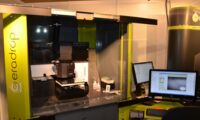- ***** LG Display's OLED TV panels proven to support healthy sleep patterns *****
- ***** Inuru's OLED technology featured in Coca-Cola's light-up packaging *****
- ***** Tom Kerchiss, RK Print Coat Instruments: "Trusting the pilot" *****
- ***** Exclusive: Ynvisible CEO Ramin Heydarpour: “Bridging the gap in the wearables industry” *****
- ***** Quad Industries: Advancing muscle activity monitoring with textile HD-EMG grids *****

Thinfilm builds first stand-alone printed electronics sensor system
Products
Read more … Thinfilm builds first stand-alone printed electronics sensor system

PaperTab a runner-up for T3 Innovation of the Year
Exhibitions / Events
Read more … PaperTab a runner-up for T3 Innovation of the Year

Ceradrop announces its integration into the MGI Group
Companies / Markets
Read more … Ceradrop announces its integration into the MGI Group

Researchers build first computer using carbon nanotubes
Products
Read more … Researchers build first computer using carbon nanotubes




